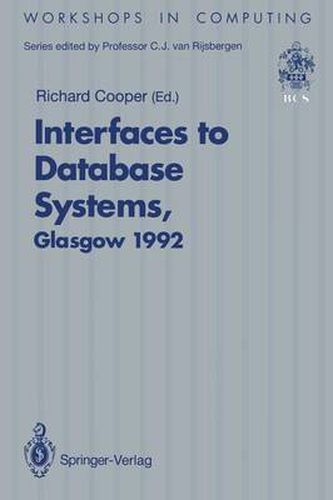Readings Newsletter
Become a Readings Member to make your shopping experience even easier.
Sign in or sign up for free!
You’re not far away from qualifying for FREE standard shipping within Australia
You’ve qualified for FREE standard shipping within Australia
The cart is loading…






This title is printed to order. This book may have been self-published. If so, we cannot guarantee the quality of the content. In the main most books will have gone through the editing process however some may not. We therefore suggest that you be aware of this before ordering this book. If in doubt check either the author or publisher’s details as we are unable to accept any returns unless they are faulty. Please contact us if you have any questions.
Despite the volume of research carried out into the design of database systems and the design of user interfaces, there is little cross-fertilization between the two areas. The control of user interfaces to database systems is, therefore, significantly less advanced than other aspects of DBMS design. As database functionality is used in a wider range of areas, such as design applications, the suitability of the user interface is becoming increasingly important. It is, therefore, necessary to begin applying the knowledge developed by HCI researchers to the specialized domain of database systems. This volume contains revised papers from the International Workshop on Interfaces to Database Systems, held in Glasgow, July 1992. The workshop aimed to develop an interaction between the design of database systems and user interfaces. It discussed both the production of interfaces tailored to particular applications, and also more general systems within which interfaces can be developed. Some of the papers concentrate on usability aspects, some discuss different interface metaphors, whilst others tackle the question of designing a general conceptual model. The latter topic is of particular importance, as it is only by achieving an abstract model of what the user understands to be in the database that the data can be associated with appropriate interface facilities. Among the contents of the volume are: integrated interfaces to publicly available databases; database query interface for medical information systems; an integrated approach to task oriented database retrieval interfaces; GRADI - a graphical database interface for a multimedia DBMS; cognitive view mechanisms for multimedia information systems; a graphical schema representation for object oriented databases; a conceptual framework for error analysis in SQL interfaces; and a browser for a version entity relationship database.
$9.00 standard shipping within Australia
FREE standard shipping within Australia for orders over $100.00
Express & International shipping calculated at checkout
This title is printed to order. This book may have been self-published. If so, we cannot guarantee the quality of the content. In the main most books will have gone through the editing process however some may not. We therefore suggest that you be aware of this before ordering this book. If in doubt check either the author or publisher’s details as we are unable to accept any returns unless they are faulty. Please contact us if you have any questions.
Despite the volume of research carried out into the design of database systems and the design of user interfaces, there is little cross-fertilization between the two areas. The control of user interfaces to database systems is, therefore, significantly less advanced than other aspects of DBMS design. As database functionality is used in a wider range of areas, such as design applications, the suitability of the user interface is becoming increasingly important. It is, therefore, necessary to begin applying the knowledge developed by HCI researchers to the specialized domain of database systems. This volume contains revised papers from the International Workshop on Interfaces to Database Systems, held in Glasgow, July 1992. The workshop aimed to develop an interaction between the design of database systems and user interfaces. It discussed both the production of interfaces tailored to particular applications, and also more general systems within which interfaces can be developed. Some of the papers concentrate on usability aspects, some discuss different interface metaphors, whilst others tackle the question of designing a general conceptual model. The latter topic is of particular importance, as it is only by achieving an abstract model of what the user understands to be in the database that the data can be associated with appropriate interface facilities. Among the contents of the volume are: integrated interfaces to publicly available databases; database query interface for medical information systems; an integrated approach to task oriented database retrieval interfaces; GRADI - a graphical database interface for a multimedia DBMS; cognitive view mechanisms for multimedia information systems; a graphical schema representation for object oriented databases; a conceptual framework for error analysis in SQL interfaces; and a browser for a version entity relationship database.